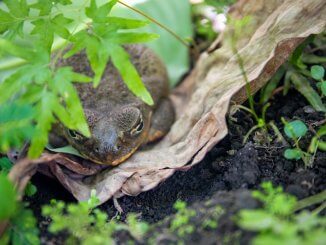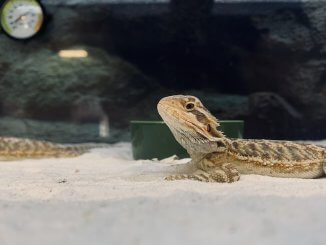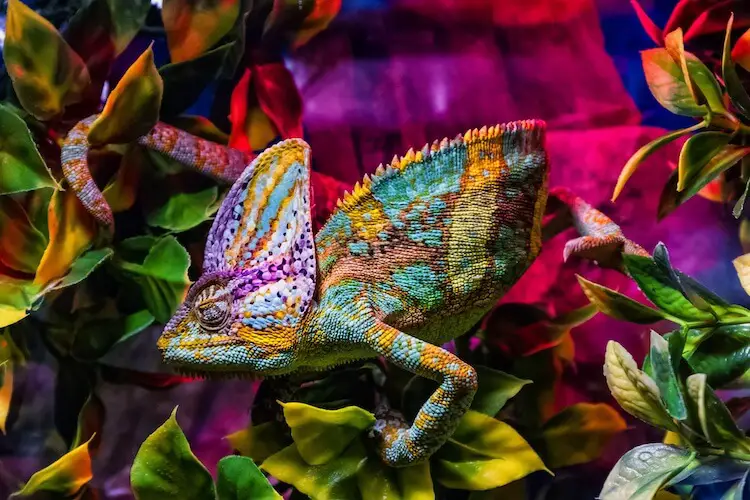
Chameleons are some of the most interesting lizards, if not animals on the planet.
Many types of chameleons are so unique that if you try to describe one to someone who hasn’t seen one before, they would think you are lying!
These lizards have tongues as long as their bodies and eyes that can move 360 degrees. They also have the ability to change the color of their skin. But, best of all, many species of chameleon make great pets.
Pet chameleons have interesting behaviors, beautiful colors and are amazing lizards.
In this article we discuss chameleon and their appearance. We then share the best pet species before concluding with how to pick one and care for one.
Types of Chameleons
Chameleons are very colorful and slow moving lizards that live in trees. There are over 200 species of chameleons that all belong to the family Chamaeleonidae. There is also a subfamily Brookesiinae that is home to pygmy chameleons.
They are one of the most interesting, unique, and entertaining lizards in the world.
Chameleons all share many unique features such as their prehensile tails, vivid colors (that change with their mood) and unique hunting techniques.
However, every type of chameleon is different.
Some species are definitely better pets than others.
For example, if you are looking for a beginner pet chameleon, you will want a small, yet brightly colored species. The Veiled (#2), Flap-Necked (#17) and Jackson’s Chameleon (#3) are all great choices. If you want a very small pet, that can be safely kept in a glass terrarium, then one of the many Pygmy kinds are a good idea.
If you are an experienced reptile keeper then you might want more of a challenge. In that case, consider a Four-Horned (#6), or even the Meller’s (#14).
Or, maybe you want an expensive, eye-catching lizard?
Any subspecies of the Panther Chameleon (#1), like the Ambilobe or Ambanja are colorful choices.
Pet Chameleon Species List
Chameleons make great pets. If you are looking for an interesting lizard to take care of, the chances are there is a type of chameleon that suits you. Below is a table of the best pet chameleon species as well as what they look like and their price.
| # | Species | Price | Color | Size |
|---|---|---|---|---|
| 1 | Panther | $300 | Variable from green, to yellow, to neon blue | 16 – 22 inches |
| 2 | Veiled | $50+ | Green with yellow markings | 10 – 22 inches |
| 3 | Jackson’s | $35+ | Green | 8 – 12 inches |
| 4 | Dwarf Jackson’s | Unknown | Green | 7 – 8 inches |
| 5 | Ambilobe Panther | $300+ | Red, blue, green, yellow, orange | 16 – 22 inches |
| 6 | Four-Horned | $100+ | Greenish – yellow | 10 – 14 inches |
| 7 | Parson’s | $1,000+ | Combinations of green, blue, white, yellow, and brown | 16 – 28 inches |
| 8 | Cuban False | $150 | Gray or tan | 6 – 7 inches |
| 9 | Pygmy | $50+ | Gray or tan | 3 – 4 inches |
| 10 | Bearded Pygmy | $50 | Brown, tan or green | 3 inches |
| 11 | Usambara Pitted Pygmy | $50 | Tan or gray | 3 inches |
| 12 | Carpet | $200+ | Combination of black and yellow, orange, red, blue, green, or purple, | 7 – 8 inches |
| 13 | Ambanja Panther | $300+ | Blue, red, green, purple | 16 – 22 inches |
| 14 | Meller’s | $150+ | Green and yellow | 20 inches |
| 15 | Senegal | $30+ | Shades of green | 6 – 8 inches |
| 16 | Fischer’s | $100+ | Green | 8 – 15 inches |
| 17 | Flap-Necked | $50 | Green and black | 8 – 12 inches |
Best Pet Chameleon
1. Panther
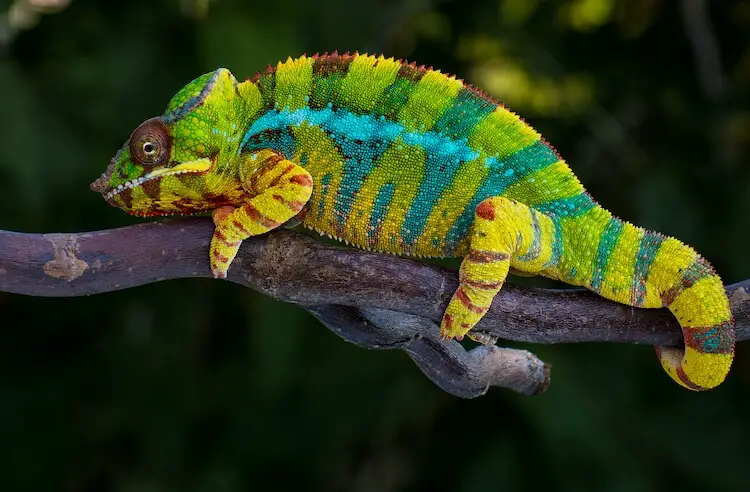
Panthers (Furcifer pardalis) are one of the most popular pet chameleon species. Because of this, they can be expensive. Many adults are sold for around $300, but particularly vivid individuals can cost $500.
Their popularity comes from their color, ease of care and tolerance of handling.
Panther species are extremely beautiful and have variable, yet vivid color patterns. They are considered to be one of the most colorful chameleon species. They often have a stripe along their side, and can be just about any color you can imagine. From green, to yellow, to neon blue, and anything in between!
Males have ridges along each side of the head and normally grow larger than females. However, both genders are big lizards
Panther Chameleons also need much less-intensive care than many other types of chameleons. Their care needs are very basic.
These lizards are also one of the most tolerant of handling and interaction.
They are best for a beginner who wants to interact with their pet.
2. Veiled
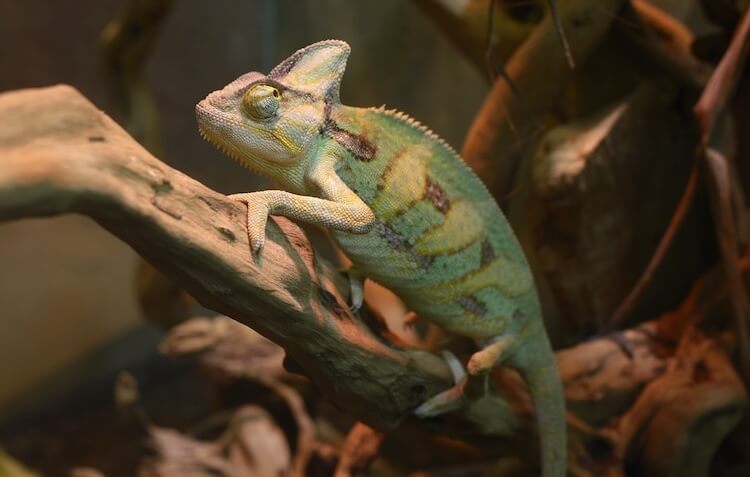
Veiled Chameleons (Chamaeleo calyptratus) are another very popular pet species, especially with beginners. They are also one of the easiest chameleon species to find as they are in many pet stores, sometimes for as low as $50.
Veiled species are the easiest type of chameleon for beginners to care for.
As long as their basic husbandry needs are met, they thrive as pets. Although, they are not as happy being handled as other species.
Their $50 price, along with their simple care needs, makes them a great pet for first time keepers.
These lizards are native to Yemen and Saudi Arabia. This is why they are also called Yemen Chameleons. They get their common name from the large ‘casque’ on top of their heads. These casques are larger on males than on females.
They may not be as variable and vivid as other species, but Veiled types are still very beautiful. Their base color is green, but they often have vertical stripes of yellow, brown, or even pale blue.
3. Jackson’s
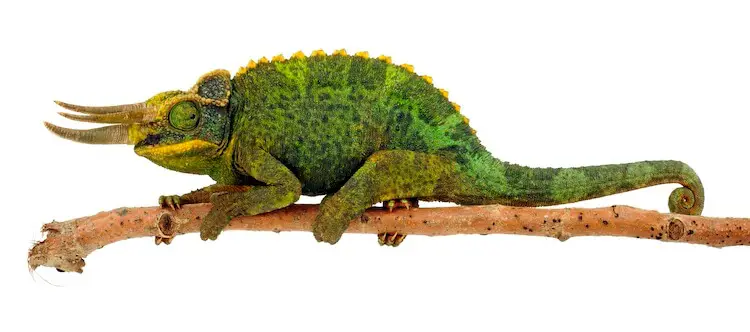
The Jackson’s Chameleon (Trioceros jacksonii) is a small species that is from Kenya and Tanzania, in Eastern Africa. They are also called Three-Horned Chameleons because males have three large horns on the top of their head.
Their horns, and their small size, make them a popular choice. Because of their popularity they are readily available at many pet stores for under $100.
As far as color goes, Jackson’s are rather ‘basic’ when compared to other types of chameleons.
Instead of a mix of many different colors, they are mostly solid green, with darker brown or green markings.
Unfortunately, Jackson’s need more care than most. So whilst they are a good beginner species, they are not a great one for first time keepers.
4. Dwarf Jackson’s
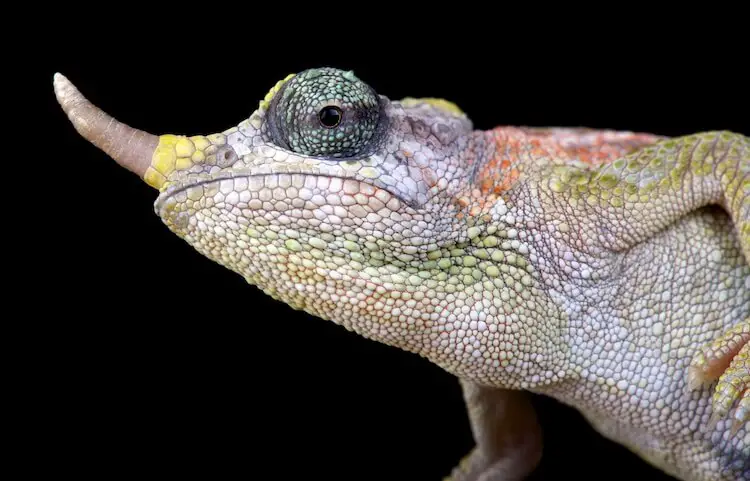
The Dwarf Jackson’s (Trioceros jacksonii merumontanus) is a rare subspecies of the Jackson’s Three Horned Chameleon. Their care is similar to other Jackson’s Chameleons. This lizard gets its name, merumontanus, from Mount Meru in Tanzania. This is the only region in the world where they can be found.
As the name dwarf suggests, this subspecies does not grow as large as other Jackson’s.
They are a mostly uniform blue-green with some yellow on their head. Males have three large horns on their heads and females have one small horn.
Since 20016, Tanzania has put strict export restrictions on their native wildlife. Because of these export restrictions, pet species are very rare in the United States.
5. Ambilobe Panther
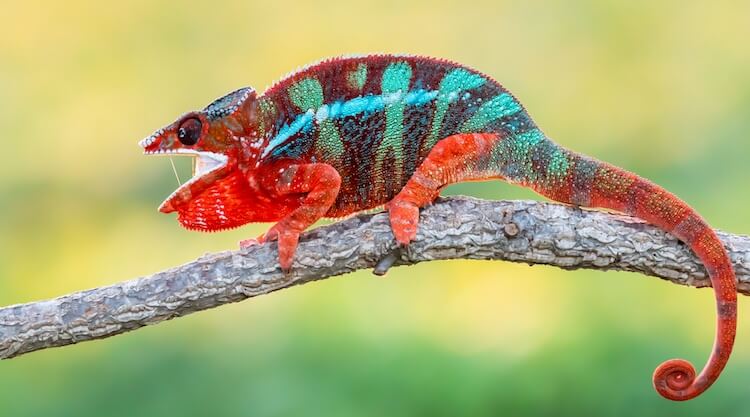
Ambilobe Panthers (Furcifer pardalis ssp.) are one of several subspecies of the Panther.
This subspecies is the most popular type of Panther Chameleon. They are often considered to be the most beautiful color of any Chameleon. They also have all of the characteristics that make Panther popular: simple care routine, large size and easy to handle.
Ambilobe species have extremely bright colors. These lizards are normally vivid combinations of red, blue, green yellow, orange, and even white.
Unlike many chameleons, Ambilobes are one of the most docile species. Some males will crawl onto their keeper’s hands when their enclosure is being cleaned.
All of these positives make the Ambilobe an expensive pet. Adults are $300 or more depending on their size and color.
6. Four-Horned
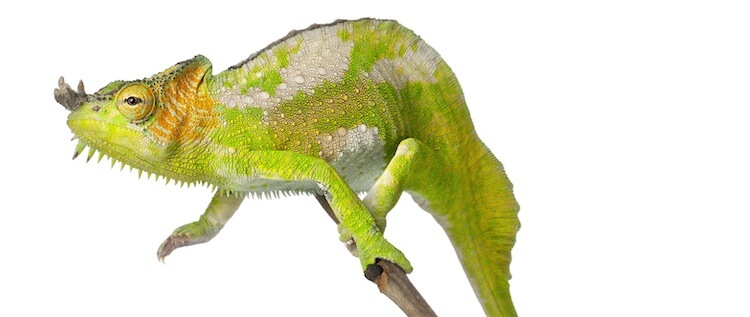
The Four-Horned Chameleon (Trioceros quadricornis) comes from the same genus as the Jackson’s. Both Chameleons share similar characteristics. They are also very similar in color and have a uniform greenish-yellow with lighter markings ranging from blue to purple.
Unlike the Jackson’s, the Four-Horned Chameleon grows a few inches larger.
It also has four horns on its head, not three. However, these horns are not as large as those on the Jackson’s.
This species of Chameleon is native to mountainous rainforests in Cameroon.
Their natural environment is very moist, and quite cold. Temperatures do not normally exceed 80 degrees Fahrenheit. They are very sensitive to high temperatures and low humidity. This makes them difficult to properly care for as pets, especially for beginners.
These reptiles need advanced care and an experienced keeper.
7. Parson’s
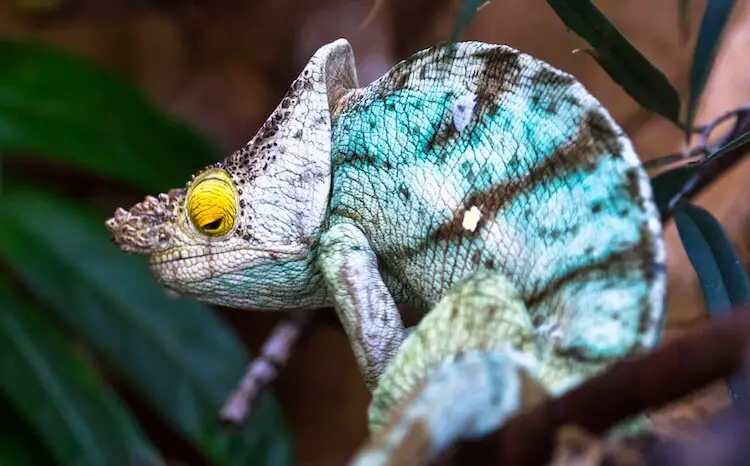
Parson’s Chameleons (Calumma parsoni) are some of the giants of the chameleon world!
The largest individuals of this species can grow bigger than any type of Chameleon and reach 70cm. Because of their giant size, some individuals may require a large reptile enclosure. Apart from that, caring for Parson’s Chameleons is very similar to caring for other species.
Parson’s do not have immediately distinguishable characteristics
Instead, these pet lizards have some amazing colors.
This species is extremely variable in color and pattern. They are combinations of green, blue, white, yellow and brown. They also have large, dark diagonal stripes on their sides. Some individuals are almost solid white with green stripes!
Their colors make them a very popular species to keep, but unfortunately, they come with a cost.
Many Parson’s cost upwards of $1,000. Partly because of their color, and partly because breeding these lizards is not a quick process. Most eggs do not hatch until about 18 months after being laid!
8. Cuban False
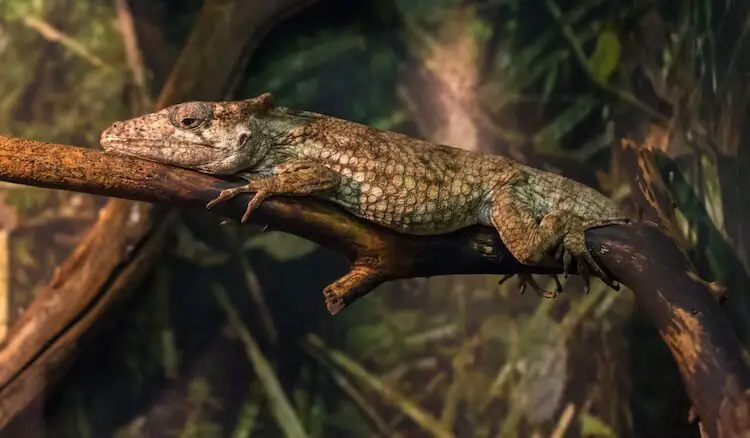
The Cuban False (Anolis barbatus) is not actually a real chameleon.
This lizard is a species of anole, belonging to the family Dactyloidae.
Despite being in an entirely different lizard, the Cuban False does have several characteristics that make them similar to Chameleons. The Cuban False has a casque on its head. These lizards also have the ability to move their eyes independent of each other.
Unlike other chameleons, the Cuban False is normally a grayish-tan color. They do not have the many vivid colors that Chameleons do.
Regardless of their color, they are very unique pet lizards.
Cuban False anoles are also far cheaper than many species in this list.
9. Pygmy
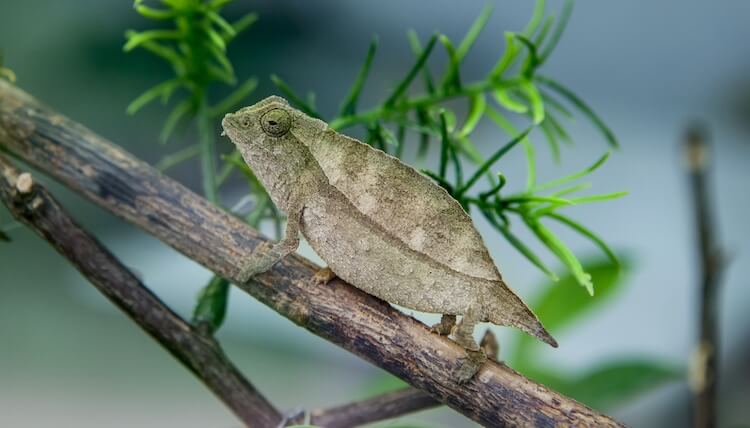
There are several species of Pygmy Chameleon. These lizards all come from the genus Rhampholeon and are collectively called Pygmy or African Leaf Chameleons.
Pygmy lizards are not like many chameleons on our list.
The first difference is their size. Pygmies do not grow much larger than three inches, hence their name. They are definitely some of the cutest pets on our list.
Other than their size, Pygmy Chameleons also have short tails. Most chameleons have long, prehensile tails to help with climbing and living in trees. Pygmies do not need long prehensile tails for a life spent in leaf litter.
There are several species of Pygmy, but most can be purchased for under $200.
They are a great choice for someone who wants a smaller, unique species of lizard.
10. Bearded Pygmy
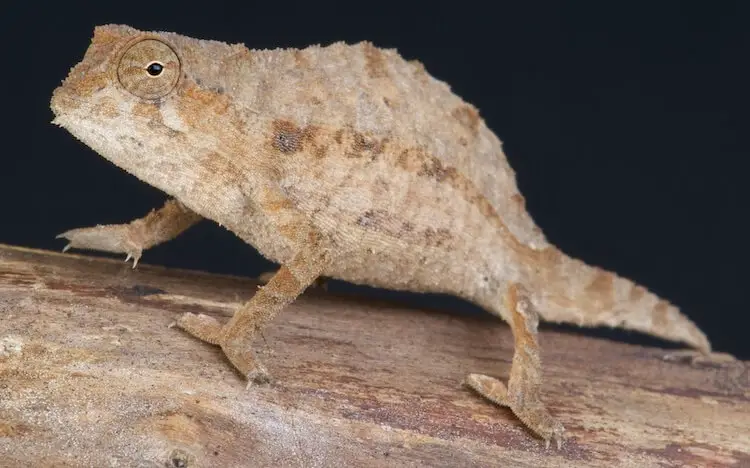
The Bearded Pygmy (Rieppeleon brevicaudatus) is one of many Pygmy Chameleon species. Like most species in their genus they are very small and do not live in trees.
Most species in the genus Rhampholeon are very similar.
Bearded Pygmies are a plain species. They can change colors to some extent, but are typically a muted brown or tan. They are excellent at blending in with their surroundings.
From a side view the Bearded Pygmy has the same shape and color as a small leaf.
11. Usambara Pitted Pygmy
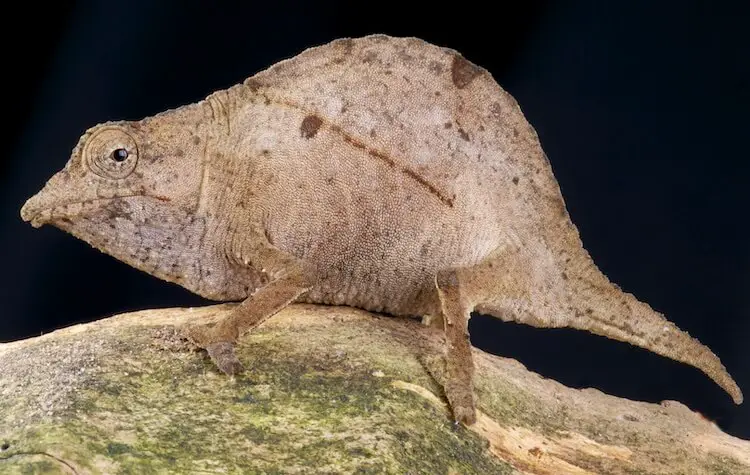
The Usambara Pitted Pygmy Chameleon (Rhampholeon temporalis) is another small species of Pygmy Chameleon.
These chameleons share many characteristics with other members of their genus. They are normally a shade of tan, brown, or gray, with patterns that often resemble a dead leaf. The Usambara Pitted Pygmy also has diagonal stripes on the sides of its body.
This species also has flattened lips, like a bird’s beak. These lips, along with their longer tails, help to distinguish them from other Pygmy species.
Usambara Pitted Pygmies are recommended for experience reptile keepers only.
They have very specific high humidity requirements which can pose a challenge to first time keepers.
Compared to many pet chameleons, they are relatively cheap and be purchased for $50.
12. Carpet
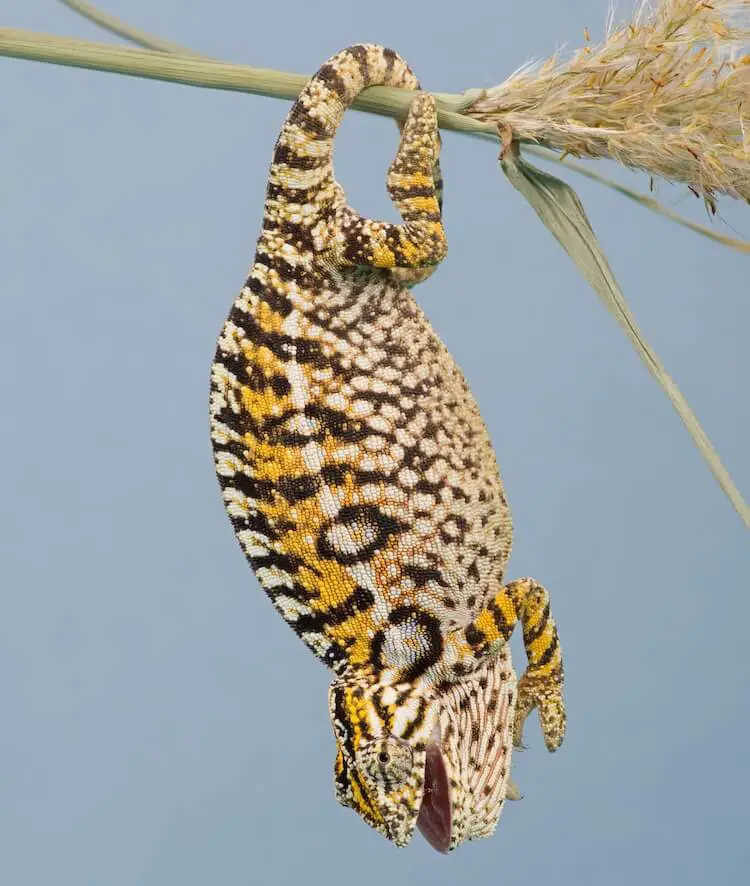
The Carpet Chameleon (Furcifer lateralis) is a brightly colored type of Panther Chameleon found on the Island of Madagascar. They are very common in their range and live in a wide range of habitats, like deserts, rainforests, and high altitudes.
These lizards grow larger than the three Pygmy lizards listed above, but they are small when compared to other pet chameleon species.
What they lack in size, however, they make up for in color.
Carpet Panthers are any combination of yellow, orange, red, blue, green, or purple with dark patterns. They also have darker spots on their sides.
The Carpet is less expensive than other types of Chameleon, but they can still cost upwards of $200.
13. Ambanja Panther
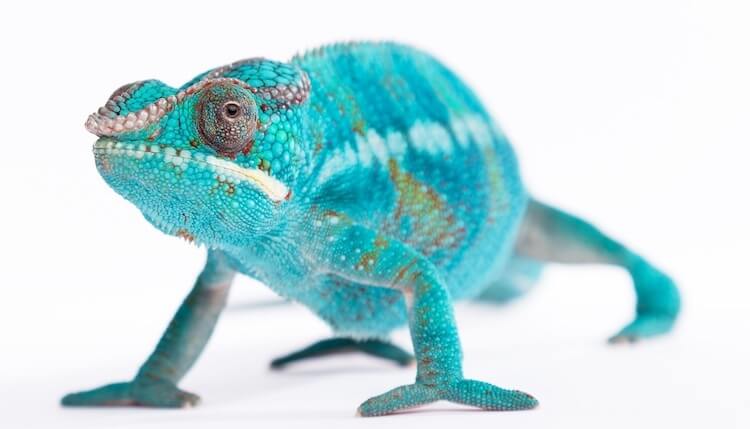
The Ambanja Panther (Furcifer pardalis ssp.) is another popular subspecies of the Panther Chameleon. Like other Panthers, the Ambanja is a big reptile with a long, prehensile tail that it uses to help navigate the branches of trees.
Ambanja Panthers are nearly unmistakable.
The Ambanja is an extremely bright, electric blue color. They sometimes have reds, greens, and purples mixed in, but most are solid blue.
Their solid blue makes them one of the most popular pet chameleons.
Caring for this species is similar to caring for any Panther species. It is not extremely difficult, but it is also not recommended for beginners, due to the high price and high humidity requirements.
14. Meller’s
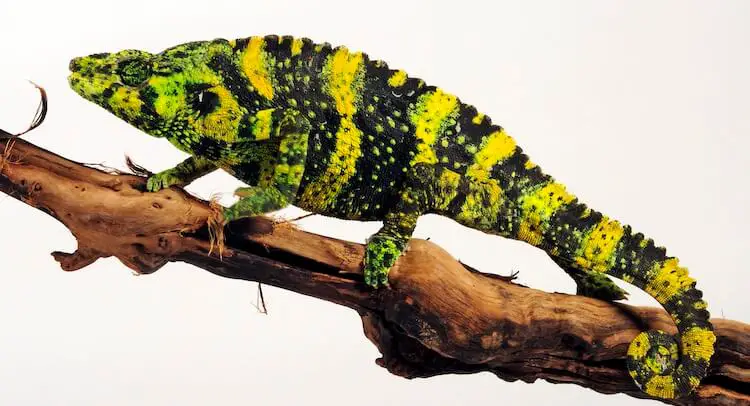
The Meller’s Chameleon (Trioceros melleri) is a large lizard found in the East African Countries of Malawi, Mozambique, and Tanzania. They are the largest chameleons outside of Madagascar, growing up to two feet in length. In the wild these lizards grow big enough to eat not only insects, but also small birds.
Meller’s are also called the Giant One-Horned Chameleon because of their enormous size.
Like their Jackson’s relative, Meller’s also have horns. However, instead of three horns, they have a single, small horn on the tip of their snout.
Meller’s typically have dark spots on top vertical bars of green and yellow.
Unfortunately this lizard is not very resistant to stress or improper husbandry conditions. This makes them extremely hard to care for. It is best to leave this species to the experts.
15. Senegal
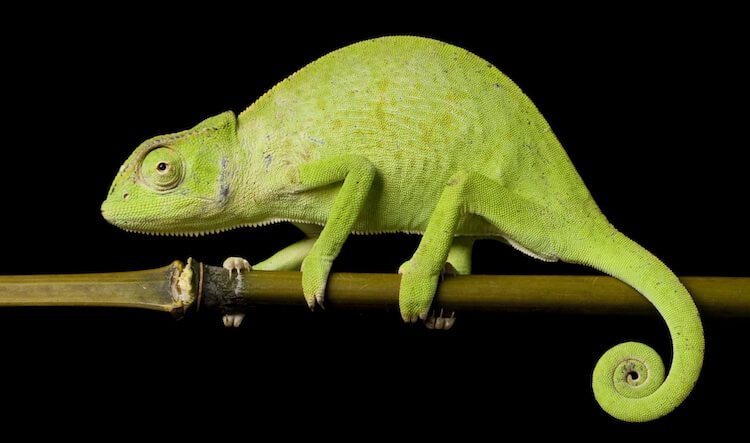
The Senegal (Chamaeleo senegalensis) is a popular species of chameleon due to its shy temperament and small adult size. These lizards are bigger than Pygmys, but smaller than species like the Panther.
Senegal Chameleons are very attractive lizards, but their color varies depending on their mood and surroundings. Many are a solid, soft green, which sometimes include darker spots.
Although most Senegal species have a calm personality, they are not very tolerant of handling.
They thrive as pets when kept by experienced keepers who are not interested in handling them. Their high humidity requirements can pose a challenge to new keepers.
16. Fischer’s
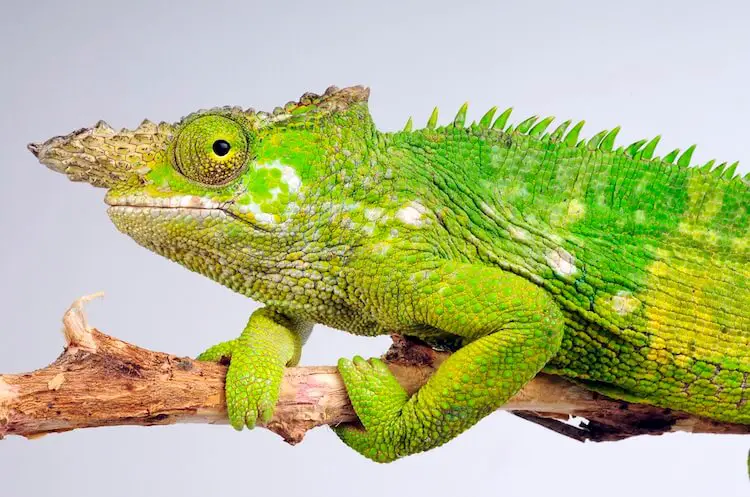
Fischer’s Chameleons (Kinyongia fischeri ssp.) are a very unique type of chameleon found in the Nguu mountain ranges of Tanzania.
Fischer’s often have long tails, which has led to some subspecies being called Monkey-Tailed Chameleons! Males also have a pair of long horns, giving this species another common name, the Western Usambara Two-Horned Chameleon.
This lizard is typically different shades of green, ranging from a dark greenish-brown to vivid lime green.
17. Flap-Necked
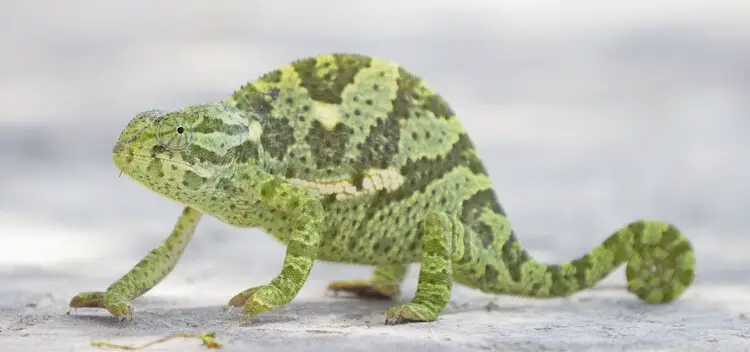
Flap-Necked Chameleons (Chamaeleo dilepis) are a popular beginner chameleon from Southern Africa. They are a very manageable size and have simple care requirements because they do not have extremely high humidity requirements.
Apart from the flaps on their neck, these lizards have the famous ‘chameleon look’. They have a small casque, long tail and are normally a range of green colors. But, some species have a brown or orange pattern.
Provided the keeper does their research these chameleons are great for beginners.
Which species stood out to you the most? Let us know in the comments below.

